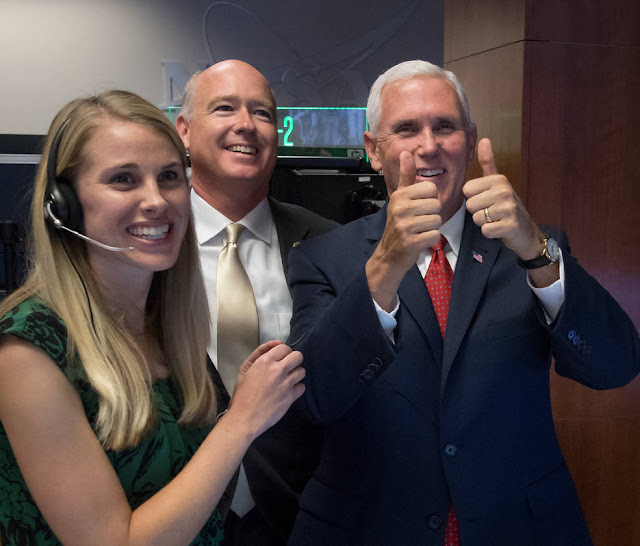The moon shines bright, in such a night as this.
- William Shakespeare. |
| Vice President Mike Pence speaking at the National Space Council , October 5, 2017 (photos courtesy of NASA unless otherwise indicated). |
About every five minutes, NASA changes its focus. It's asteroids, then it's Mars, deep space probes, and they even throw Venus into the mix occasionally with fanciful Youtube videos.
In October 2017, another change of focus, and one that actually makes sense given the capabilities of the US space program.
A mission to the Moon.
 |
| President Donald Trump, here with astronaut Kate Rubins and Ivanka Trump on 24 April 2017, has put VP Pence in charge of NASA policy (Photo: Susan Walsh/AP). |
It is perhaps a bit silly to spend too much time on any of NASA's ever-shifting priorities, but the Moon has one prime attraction: NASA knows that it can actually get there and complete missions on the Lunar surface. The only things NASA has sent to Mars are rovers which send back nice pictures but don't really settle conclusively issues such as ancient life. While their scientific missions are extremely interesting and educational, the rovers are limited for any number of reasons. As for sending manned missions to Mars... regardless of what else you may hear, those are still in the realm of science fiction and will remain so for decades.
 |
| William Gerstenmaier, right, examines scorched tiles on space shuttle Endeavour in 2007. |
NASA itself knows that Mars is beyond its capabilities. Oh, NASA could do it - if you gave it unlimited amounts of money and time. It also could go to Alpha Centauri, too, given the same latitude. However, we live in the real world, something acknowledged by NASA's chief of human spaceflight William H. Gerstenmaier in July 2017:
I can't put a date on humans on Mars, and the reason really is the other piece is, at the budget levels we described, this roughly 2 percent increase, we don’t have the surface systems available for Mars. And that entry, descent and landing is a huge challenge for us for Mars.Anyone closely following the progress of the US space program knew this already, but it was nice to actually hear the truth from NASA itself.
 |
| As of 2017, no human has been out of low-earth orbit, let alone to the Moon, since the Nixon administration in the early 1970s. |
Okay, so now you think I'm nothing but a Negative Nancy or something. Why, of course we can just fly off to Mars on schedule, you say. Well, NASA says that we can't. Instead, on 5 October 2017, Vice President Mike Pence signalled the new focus of the space program at a space council meeting:
We will return American astronauts to the Moon, not only to leave behind footprints and flags, but to build the foundation we need to send Americans to Mars and beyond. The Moon will be a stepping-stone, a training ground, a venue to strengthen our commercial and international partnerships as we refocus America’s space program toward human space exploration.So, there's the new priority. Presumably, President Trump's pick to head NASA, Representative Jim Bridenstine (R–OK), is on board with this plan.
 |
| Jessica Duckworth, left, U.S. Rep. Robert Aderholt of Alabama, center, and VP Pence. |
In a battle cry that resonates, Pence said:
America seems to have lost our edge in space,” said Pence, “and those days are over.There is a lot of skepticism about this focus on the Moon, figuring it is unfeasible. Interestingly, much of it comes from those who though going to Mars was doable. Since going to Mars would be vastly more complicated and risky than going to the Moon again, a trip to the Moon should be fairly straightforward if it is done instead of going to Mars.
 |
| NASA's Marshall Space Flight Center in Huntsville, Alabama. |
Pence gave an idea how this would be achieved:
American companies are on the cutting edge of space technology, and they’re developing new rockets, spaceships, and satellites that will take us further into space faster than ever before. By fostering much stronger partnerships between the federal government and the realm of industry, and bringing the full force of our national interests to bear, American leadership in space will be assured.VP Pence has been working on this new policy assiduously. He visited NASA's Marshall Space Flight Center in Huntsville, Alabama, on Monday, Sept. 25, 2017. This gave Pence some first-hand looks at what actually is achievable, rather than simply drinking in the wishes and hopes of people obsessed with Mars.
 |
| The U.S. flag still stands on the surface of the Moon, and may be joined by another one in the not-too-distant future. |
In any event, it is all just talk for now. It would be nice to see NASA actually do some things they plan, rather than just talk about them. We shall continue following events hopefully.
2017
